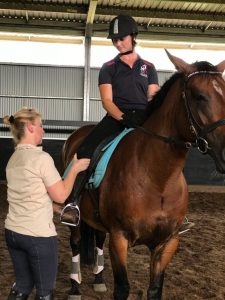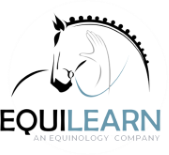
EQ700: Horse, Saddle and Rider Interaction: The Principles of Saddle Fitting
Date:
Location:
Cost:
Duration:
This comprehensive four-day course delves into the intricate relationship between saddle fit, biomechanics and anatomy. Students will learn not only how to fit a saddle correctly, but will leave armed with an abundance of skills to address common saddle fitting problems.
This course is suited to riders, trainers and equine professionals (bodyworkers, veterinarians, chiropractors, farriers/trimmers, dentists) interested in understanding saddle fit and biomechanics. Those that work as equine healthcare professionals need to be able to assess whether or not the horse/rider combination is on the right track with their current gear, and back up findings to the owner or trainer for the welfare of the horse. In situations where a horse is recovering from an injury or has had time-off, a temporary solution using corrective pads or shims while the normal posture returns may be necessary.
*Please note – while this course will give you the skills to evaluate and correctly fit a saddle for your own horse or your client horses in between professional fittings, it will not prepare you to work professionally as a saddle fitter.
There are three parts to our saddle fitting course, totaling 263 hours. Prior to coming onsite, students must first complete the OAES: Intro to Saddle Fitting course (online, 25 hours) as well as the EQ700B: Saddle Fitting History & Concepts course (online, 50 hours).
This course runs from 8:00am – 5:00pm, with 30 minutes for lunch and (2) hours of evening studies.
- Saddle Design: History, Innovations & Alternatives
- Saddle Assessment: Design, Safety & Condition
- Saddle Fitting Criteria
- Assessing the Horse
- Back Measurements
- Assessing the Rider
- Horse, Saddle and Rider Interaction
- Clinical Reasoning: Saddle Fitting Assessment Teams
- Saddle Testing Demonstrations
- Saddle Fitting Interventions and Effects
- Clinical Reasoning: Intervention Teams
This class is suitable for equine healthcare professionals or owners looking for continuing education. Those without prior knowledge of veterinary vocabulary and anatomy are strongly encouraged to first register for the EQ50: Equine Anatomy Distance Study Course. Horse handling skills and a thorough understanding of equine safety is a must.
Prior to coming onsite for this course, students must first complete the following online courses:
- OAES: Introduction to Saddle Fitting (25 hours)
- EQ700B: Saddle Fitting History & Concepts (50 hours)
Please note that learning activities MUST be completed for these courses PRIOR to coming onsite for the EQ700.
*The EQ700 is required for the Equinology® Equine Body Worker Level III certification.
Required Text:
None
Course Materials (included in tuition):
Course Workbook & Handouts
Externship (included in tuition):
Externship Grading and Certificate
Suggested Reading:
Saddle Fitting A to Z: DVD by Dr. Kerry Ridgway
The Horse’s Pain-Free Back and Saddle-Fit Book by Joyce Harman, DVM
The Horse in Motion: The Anatomy and Physiology of Equine Locomotion by Pilliner, Elmhurst, and Davies
Recognizing the Horse in Pain by Dr. Joanna Robson
David Genadek is a Master Saddle Maker with more than 25 years of dedication to his craft. His journey began as an apprentice with some  of the top saddle makers and manufacturers in the country, including Crates Leather Company. Over the years, David honed his expertise in the fine arts of carving, tool making, leather production, and pattern design.
of the top saddle makers and manufacturers in the country, including Crates Leather Company. Over the years, David honed his expertise in the fine arts of carving, tool making, leather production, and pattern design.
In 1994, he founded About the Horse, Inc., a leading saddle design and manufacturing company known for its innovative approach to barrel racing, trail riding, reining, and roping saddles. What sets David’s designs apart is his commitment to returning to the basic anatomy of the horse, ensuring that each saddle is crafted with the horse’s comfort and biomechanics in mind.
A lifelong student, David has studied under Dr. Deb Bennett, a renowned expert in the biomechanics of equine anatomy, and collaborates with professionals like Peggy Cummings, a nationally recognized riding instructor. His partnerships with experts such as Mark Rashid and Harry Whitney further fuel his mission to create saddles that not only fit the horse perfectly but also seat the rider in harmony with the horse’s natural movement.
Beyond the workshop, David is a passionate educator. He hosts clinics across the U.S. and Canada, teaching horse owners how to correctly place and secure saddles for optimal comfort and performance. These hands-on workshops dive into key topics like selecting the right padding, understanding how a rider’s position affects saddle fit, and addressing the unique saddle needs for both men and women. David covers both Western and English saddles, and participants are encouraged to bring their own saddles for personalized demonstrations—all with no sales pitch, just education.
David’s work has been featured in Horse & Rider and Western Horseman, where his expertise continues to inspire. His goal remains steadfast: to keep learning and sharing his knowledge, ensuring that saddles are not just an accessory, but an essential tool for the well-being of both horse and rider.
A $350 deposit is required to hold your spot in a course – the remainder of the tuition is due at least 45 days prior to the course start date (60 days for international instructors). The $350 deposit is nonrefundable and nontransferable, and is credited to the total tuition for the course. Confirmation letters, course outlines, required pre-study (if applicable), directions and lodging options will be sent when the $350 deposit has been received.
REMINDER: Completion of the OAES: Intro to Saddle Fitting and EQ700B: Saddle Fitting History & Concepts online courses is required PRIOR to coming onsite for the EQ700.
This comprehensive four-day course delves into the intricate relationship between saddle fit, biomechanics and anatomy. Students will learn not only how to fit a saddle correctly, but will leave armed with an abundance of skills to address common saddle fitting problems.
This course is suited to riders, trainers and equine professionals (bodyworkers, veterinarians, chiropractors, farriers/trimmers, dentists) interested in understanding saddle fit and biomechanics. Those that work as equine healthcare professionals need to be able to assess whether or not the horse/rider combination is on the right track with their current gear, and back up findings to the owner or trainer for the welfare of the horse. In situations where a horse is recovering from an injury or has had time-off, a temporary solution using corrective pads or shims while the normal posture returns may be necessary.
*Please note – while this course will give you the skills to evaluate and correctly fit a saddle for your own horse or your client horses in between professional fittings, it will not prepare you to work professionally as a saddle fitter.
There are three parts to our saddle fitting course, totaling 263 hours. Prior to coming onsite, students must first complete the OAES: Intro to Saddle Fitting course (online, 25 hours) as well as the EQ700B: Saddle Fitting History & Concepts course (online, 50 hours).
This course runs from 8:00am – 5:00pm, with 30 minutes for lunch and (2) hours of evening studies.
- Saddle Design: History, Innovations & Alternatives
- Saddle Assessment: Design, Safety & Condition
- Saddle Fitting Criteria
- Assessing the Horse
- Back Measurements
- Assessing the Rider
- Horse, Saddle and Rider Interaction
- Clinical Reasoning: Saddle Fitting Assessment Teams
- Saddle Testing Demonstrations
- Saddle Fitting Interventions and Effects
- Clinical Reasoning: Intervention Teams
This class is suitable for equine healthcare professionals or owners looking for continuing education. Those without prior knowledge of veterinary vocabulary and anatomy are strongly encouraged to first register for the EQ50: Equine Anatomy Distance Study Course. Horse handling skills and a thorough understanding of equine safety is a must.
Prior to coming onsite for this course, students must first complete the following online courses:
- OAES: Introduction to Saddle Fitting (25 hours)
- EQ700B: Saddle Fitting History & Concepts (50 hours)
Please note that learning activities MUST be completed for these courses PRIOR to coming onsite for the EQ700.
*The EQ700 is required for the Equinology® Equine Body Worker Level III certification.
Required Text:
None
Course Materials (included in tuition):
Course Workbook & Handouts
Externship (included in tuition):
Externship Grading and Certificate
Suggested Reading:
Saddle Fitting A to Z: DVD by Dr. Kerry Ridgway
The Horse’s Pain-Free Back and Saddle-Fit Book by Joyce Harman, DVM
The Horse in Motion: The Anatomy and Physiology of Equine Locomotion by Pilliner, Elmhurst, and Davies
Recognizing the Horse in Pain by Dr. Joanna Robson
David Genadek is a Master Saddle Maker with more than 25 years of dedication to his craft. His journey began as an apprentice with some  of the top saddle makers and manufacturers in the country, including Crates Leather Company. Over the years, David honed his expertise in the fine arts of carving, tool making, leather production, and pattern design.
of the top saddle makers and manufacturers in the country, including Crates Leather Company. Over the years, David honed his expertise in the fine arts of carving, tool making, leather production, and pattern design.
In 1994, he founded About the Horse, Inc., a leading saddle design and manufacturing company known for its innovative approach to barrel racing, trail riding, reining, and roping saddles. What sets David’s designs apart is his commitment to returning to the basic anatomy of the horse, ensuring that each saddle is crafted with the horse’s comfort and biomechanics in mind.
A lifelong student, David has studied under Dr. Deb Bennett, a renowned expert in the biomechanics of equine anatomy, and collaborates with professionals like Peggy Cummings, a nationally recognized riding instructor. His partnerships with experts such as Mark Rashid and Harry Whitney further fuel his mission to create saddles that not only fit the horse perfectly but also seat the rider in harmony with the horse’s natural movement.
Beyond the workshop, David is a passionate educator. He hosts clinics across the U.S. and Canada, teaching horse owners how to correctly place and secure saddles for optimal comfort and performance. These hands-on workshops dive into key topics like selecting the right padding, understanding how a rider’s position affects saddle fit, and addressing the unique saddle needs for both men and women. David covers both Western and English saddles, and participants are encouraged to bring their own saddles for personalized demonstrations—all with no sales pitch, just education.
David’s work has been featured in Horse & Rider and Western Horseman, where his expertise continues to inspire. His goal remains steadfast: to keep learning and sharing his knowledge, ensuring that saddles are not just an accessory, but an essential tool for the well-being of both horse and rider.
A $350 deposit is required to hold your spot in a course – the remainder of the tuition is due at least 45 days prior to the course start date (60 days for international instructors). The $350 deposit is nonrefundable and nontransferable, and is credited to the total tuition for the course. Confirmation letters, course outlines, required pre-study (if applicable), directions and lodging options will be sent when the $350 deposit has been received.
REMINDER: Completion of the OAES: Intro to Saddle Fitting and EQ700B: Saddle Fitting History & Concepts online courses is required PRIOR to coming onsite for the EQ700.
